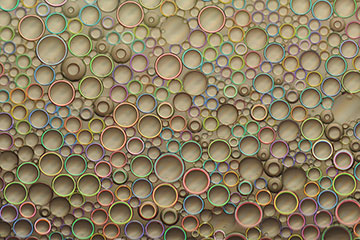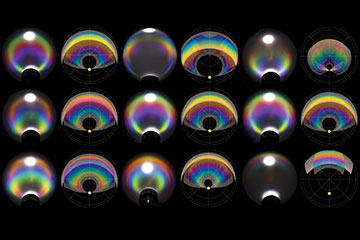
By tuning size, illumination angle, and curvature, a team of U.S. engineers produces brilliant colors, in predictable patterns, from otherwise transparent droplets. [Image: Felice Frankel]
U.S. scientists have realized a previously unexplained form of structural color—the same phenomenon by which light reflecting off of geometric nanostructures on a butterfly’s wings generates color—that allows ordinary, colorless water droplets on a transparent surface to produce vivid hues (Nature, doi: 10.1038/s41586-019-0946-4).
By shining light onto a surface covered in a fine mist of perfectly identical liquid droplets, the team produced a bright color that could be predicted by a mathematical model. The team, including scientists from the Massachusetts Institute of Technology (MIT) and the Pennsylvania State University, expects that the controllable mechanism could support the development of cosmetics, color-changing paints or adaptive camouflage.
Total internal reflection
The team stumbled upon this structural-color effect while studying the internal structure of droplet emulsions of various oils and water-based surfactants. The researchers were struck by how colorful the transparent droplets appeared to be, and how the droplets seemed to change color depending on the viewing angle.
Their first thought was that it was the same phenomenon responsible for rainbows, but the droplets were hemispherical, unlike the spherical raindrops that light interacts with to produce a rainbow. The team dug further and realized that the dome-like curve of a hemisphere allows for total internal reflection (TIR)—an optical effect that’s not possible in perfect spheres.
The same effect that allows optical fiber to carry light across long distances with low loss, TIR occurs when light strikes an interface between a high-refractive-index medium and a lower-refractive-index medium at a specific angle, such that 100 percent of light is reflected. (By contrast, the spherical raindrops that create rainbows reflect only around 5 percent of the light that hits them and transmit the rest.)
When light enters one of the hemispherical droplets, the team found, it is reflected by TIR along its concave interface, sometimes bouncing several times before exiting at a different angle. It is the path that light rays take and the way that they interfere with each other as they exit the droplet that can produce color.

Seen from above, transparent droplets in a Petri dish, illuminated with white light, appear as varying colors depending on their size and shape. [Image: Courtesy of the researchers]
Tailoring droplets to produce specific colors
The color that a droplet produces depends on specific structural and optical conditions, like the droplet’s dimensions, curvature, refractive indices and the angle of incident light. So the team devised a mathematical model to predict the color a droplet will generate using these parameters.
To test the model’s predictions, the researchers cut a ping pong ball in half and placed it over a petri dish containing droplets, creating a domed screen. They shone collimated white light from an LED through a 3-mm hole in the translucent screen and witnessed iridescent colors reflected from the drops projected onto the ceiling of the dome. They then removed the screen and photographed the droplets from different angles, circling the petri dish and observing that the colors shifted with the viewing angle.
Other experiments included testing the effect of droplet size and curvature on color production, exploiting the mechanism in multiphase droplets and 3-D printing tiny domes to produce a similar effect with solid particles. The researchers found that precisely controlling the size and shape of the droplets allowed them to predictably change the colors the droplets produced using their model.
According to the researchers, their model could be leveraged for an array of color-changing applications, including displays, sensors and powders and inks for cosmetics. The possibility of creating vibrant colors without the addition of potentially harmful synthetic dyes could be particularly attractive for consumer products.
